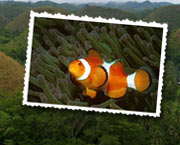Current Philippine Banknotes
IJsselstein, Saturday, 5 February 2011 (updated: Friday, 13 January 2017)
The currency in the Philippines is the Philippine peso (or officially piso), divided into 100 centavos (officially centimo). Its international abbreviation is PHP. Currently (January 2017), the U.S. dollar is worth about 49 pesos, and the euro about 52 pesos (daily update rates are on our Exchange Rate page). Current are coins of 1, 5, 10, and 25 centavos and 1, 5, and 10 pesos, and bank notes of 20, 50, 100, 200, 500 and 1000 pesos. The coins can be seen on a separate page. The Bangko Sentral ng Pilipinas (Central Bank of the Philippines) released a new series of banknotes in 2010. All designs have been redone, and a very nice consistent new series has been produced, although the connection with the old series is maintained, and the same faces, colors, and several elements of the old banknotes do return. The old banknotes are no longer legal tender since 1 January 2016, and lost all their value on 1 January 2017.
Compared with the old series, the most conspicuous changes are the addition of former President Corazon Aquino, who joined her husband Benigno S. Aquino Jr. on the 500 peso bill (and finally, he has a smile on his face), and the addition of highlights from Philippine nature on the reverse. The colors have become somewhat brighter, and the numbers indicating the values have increased in size. Furthermore, textile patterns from various regions of the country have been added to the reverse.
Especially the addition of the country's natural wonders and indigenous animals is a welcome addition, and may help the country to preserve its natural treasures. What you do not see, you do not love, and what you do not love, you do not take care of, and with those notes, Philippine nature will be seen every time you are dealing with money. Boholano's will be especially happy to see the Chocolate Hills and the tarsier pictured on the 200 peso bill.
The introduction of the new series also means the final demise 5 and 10 peso bills, which are no longer present - and causing Aguinaldo, Mabini, and Bonifacio to join the ranks of national hero's falling victim to inflation. To their consolation, we can say that they are in the pleasant company of Jose Rizal, who used to be on the 2 peso bills.
After introduction, the notes met with some harsh (and mostly undeserved) critique, and as a result it appears that the Central Bank still continues to issue the old design notes, so far for the years 2011, 2012, and 2013. This is quite unfortunate, as the new design notes are attractive, and fixing the main points of critique would be fairly straightforward.
All banknotes include a number of security features, indicated on the front side:
- embossed prints
- serial number (in variable sized figures)
- security fibers
- watermark
- see-through mark ("Pilipino" spelled in Baybayin, letters, used before the arrival of the Spanish.)
- concealed value
- security thread
- optically variable device (only on 500 and 1000 peso notes)
20 Peso
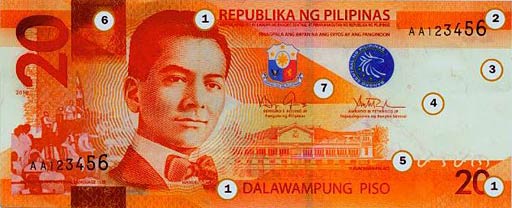
The front or obverse shows President Manuel L. Quezon (1878-1940), president of the Philippine Commonwealth from 1935 until 1944, and considered the Father of the National Language. This note, like the previous 20 Peso note, commemorates the declaration of Filipino as the National Language in 1935. The Malacańan, the Philippine presidential palace, has moved to the front.

On the back or reverse, you'll find the Banaue Rice Terraces and a Palm civet, and a woven design from the Cordilleras.
The Banaue Rice Terraces have been carved into the Cordilleras mountains in central Luzon by Ifugao tribesmen over thousands of years with very limited means.
The palm civet (Paradoxurus hermaphroditus philippinensis) is an indigenous animal in the Philippines, and curiously related to the most expensive coffee in the world, the coffee alamid, which is made from coffee beans eaten and partly digested by palm civets, and collected from their droppings.
50 Peso
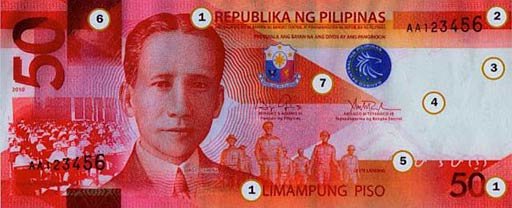
The front shows President Sergio Osmeńa (1878-1961), was President of the Philippines from 1944 to 1946. He had already become a member of the assembly in 1907, at the age of 29. He was also present with the 1944 landing of General Douglas McArthur in 1944. The "Leyte Landing" monument on Palo beach, Leyte, that commemorates this event is also shown here.
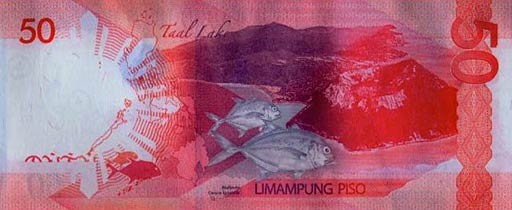
The back displays Taal Lake and the giant trevally, and embroidery design from Batangas.
Taal Lake is the deepest freshwater lake in the country. Taal volcano, an island in the middle of this lake is one of the worlds smallest volcano's, and is still regularly active.
The giant trevally (Caranx ignobilis) is a fish that only lives in the water of Taal Lake. It is locally known as Maliputo, and considered highly delicious.
100 Peso

President Manuel A. Roxas (1892-1948) is honored on the front of the 100 Peso note. He was the first president of the Philippines after independence, and died in office from a heart attack in 1948. Further depicted is the Inauguration of the Third Republic on 4 July 1946, and the Central Bank of the Philippines, of which Roxas initiated the foundation.
Some nationalists are happy that the American flag that was on the previous note has been removed in this redesign. However, the United States eagle, as well as the Spanish lion remain on the Philippine coat of arms depicted on all Philippine notes.
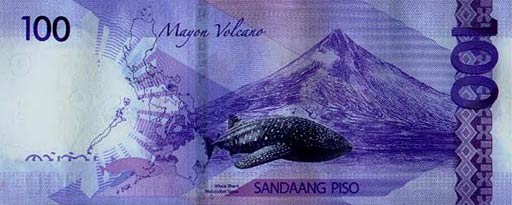
The back depicts Mayon Volcano and a whale shark, and indigenous textile from Bicol.
Mayon Volcano is an active stratovolcano in the province of Albay, in the Bicol Region. This volcano is famous for its almost perfect cone shape.
The whale shark, (Rhincodon typus), locally known as the butanding, is the largest living fish in the world, and can be found in Sorsogon, not far from Mayon Volcano. Although it is a member of the shark family, it is a gentle giant that feeds on plankton, and poises no danger to humans.
200 Peso
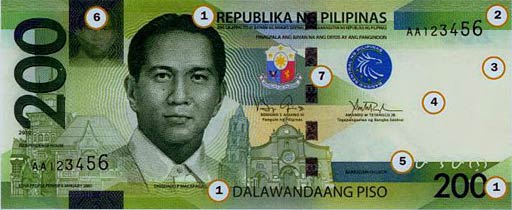
The front carries the portrait of president Diosdado P. Macapagal (1910-1997), father of former president Gloria Macapagal Arroyo, who also still poses on this note, but now neatly tucked away in the lower-left corner, commemorating EDSA People Power II. Also shown here is the Barasoain Church in Malolos, Bulacan, where in 1898 General Emilio Aguinaldo declared independence from Spanish colonial rule.
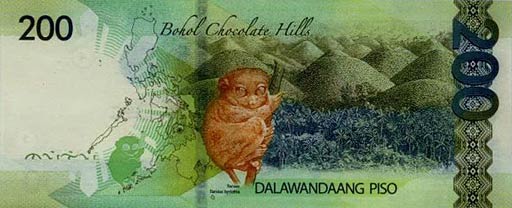
The back side shows the Chocolate Hills of Bohol, a Philippine tarsier, and textile designs from the Visayas.
The Chocolate Hills are a characteristic karst landscape in central Bohol, named after the chocolate-brown color they acquire at the end of the dry season. The exact number of those 30 to 50 meter high mounds is under dispute, but some claim to have counted 1268.
The Philippine tarsier (Tarsius syrichta) is a shy nocturnal animal, that can be found in Bohol. One of the smallest primates in the world, it can be held in one's hand, but still is capable to make jumps of three meters between trees. Besides Bohol, it can be found in Samar, Leyte, and Mindanao.
500 Peso
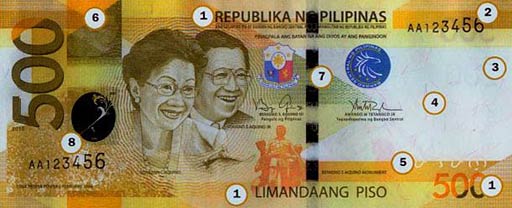
On the front of the 500 peso note, Senator Benigno Aquino Jr. (1932-1983) - no longer frowning - is now joined by his wife, President Corazon C. Aquino (1933-2009), who became president after the non-violent People Power revolution ousted Marcos from office. This side further depicts the crowds who participated in the People Power revolution and the monument for Sen. Benigno Aquino Jr.
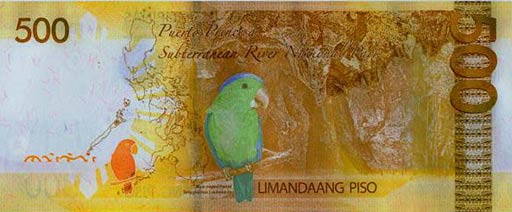
The back shows the Puerto Princesa Subterranean River, a blue-naped parrot, and woven cloth from the Southern Philippines.
The Puerto Princesa Subterranean River is an eight kilometer long underground river on Palawan, that winds through a huge cave.
The blue-naped parrot (Tanygnathus lucionensis) lives in the primary forests of Palawan and Mindoro.
1000 Peso
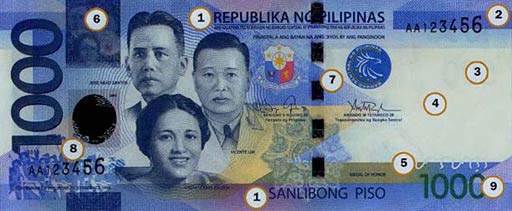
The 1000 peso note is the only one not to depict a former president. On it are three World War II heros: Josefa Llanes Escoda (1898-1945), Vicente P. Lim (1888-1944), and Jose Abad Santos (1886-1942).
Josefa Llanes Escoda was an advocate for women's rights, educator and social worker. She founded the Girl Scouts of the Philippines, and edited a newspaper. She was killed for helping prisoners of war during the Japanese occupation.
Brigadier General Vicente P. Lim, was Chief of Staff of the Philippine Army, who, although wounded, organized guerrilla activities. He was captured and killed by the Japanese.
Jose Abad Santos was the Chief Justice of the Philippine Supreme Court. He refused to cooperate with the Japanese occupation forces, and was executed for that.
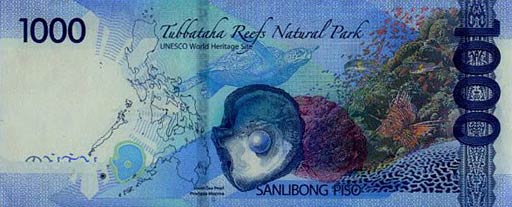
The reverse shows the Tubattaha Reef Marine Park, a South Sea pearl oyster, and tinalak or ikat-dyed abaca cloth from Mindanoa.
Tubattaha Reef Marine Park, a nature reserve of 130,000 hectares in the Sulu Sea is a unique underwater ecosystem. This huge coral reef is home to whales, dolphins, turtles, sharks, and hundreds species of fish.
The South Sea pearl oyster (Pinctada maxima) can grow some of the largest pearls in the world.
Links
- A Blog on Philippine Money.
- A movie on BSP Philippine Money
- The New Generation Philippine Banknotes (Bangko Sentral official announcement.)
- PHP Demonetization Schedule
Jeroen Hellingman
What readers think...
| Bohol Online Store wrote: |
| Tuesday, 4 February 2020 23:26:53 PHT |
| We deliver grocery items in Bohol, Philippines. If you are an OFW, overseas worker or far from Bohol, and you want to send money to your family, instead of money you can send them groceries. Visit our website at www.boholonlinestore.com Or send us an email at storebohol@gmail.com |
| Idy wrote: |
| Tuesday, 16 July 2019 09:13:34 PHT |
| We are from Hong Kong travel to Palawan 3 years ago exchange some peso didn’t use it all, so we back home with some peso for next holiday , this time we visiting Cebu, we got some peso shop doesn’t accept it.....what can we do? when we took these peso home We didn’t though that’s old money as we use these 2016.....but clearly they are old note....
Sorry to say that the old Philippine banknotes are demonetized. The last exchanged date of the old Philippine banknotes was on April 1, 2017. --- Rodelyn G. Hellingman |
| Dave rust wrote: |
| Tuesday, 16 October 2012 22:05:53 PHT |
| I think the new filipino bank notes are very good and well designed and colored. |
Also give your comments on this article
We reserve the right to remove or edit comments posted on this website. Please read our conditions of use for details. You can use <i>italics</i>, <b>bold</b>, <p> new paragraph, <a href="url">link</a>. Other markup will be removed. Use of the forums for advertising is prohibited. Enterprises located in Bohol can request to be added to the business directory.



